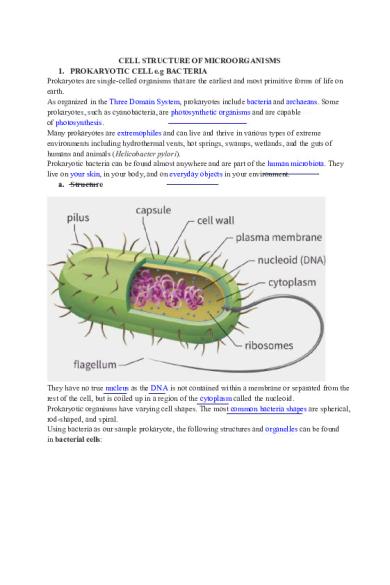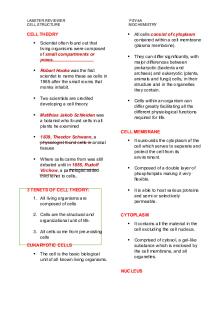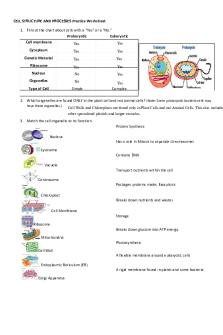CELL Structure OF Microorganisms PDF

| Title | CELL Structure OF Microorganisms |
|---|---|
| Course | Medicine |
| Institution | Kenyatta University |
| Pages | 7 |
| File Size | 475.7 KB |
| File Type | |
| Total Downloads | 68 |
| Total Views | 154 |
Summary
Notes...
Description
CELL STRUCTURE OF MICROORGANISMS 1. PROKARYOTIC CELL e.g BACTERIA Prokaryotes are single-celled organisms that are the earliest and most primitive forms of life on earth. As organized in the Three Domain System, prokaryotes include bacteria and archaeans. Some prokaryotes, such as cyanobacteria, are photosynthetic organisms and are capable of photosynthesis. Many prokaryotes are extremophiles and can live and thrive in various types of extreme environments including hydrothermal vents, hot springs, swamps, wetlands, and the guts of humans and animals (Helicobacter pylori). Prokaryotic bacteria can be found almost anywhere and are part of the human microbiota. They live on your skin, in your body, and on everyday objects in your environment. a. Structure
They have no true nucleus as the DNA is not contained within a membrane or separated from the rest of the cell, but is coiled up in a region of the cytoplasm called the nucleoid. Prokaryotic organisms have varying cell shapes. The most common bacteria shapes are spherical, rod-shaped, and spiral. Using bacteria as our sample prokaryote, the following structures and organelles can be found in bacterial cells:
Capsule: Found in some bacterial cells, this additional outer covering protects the cell when it is engulfed by other organisms, assists in retaining moisture, and helps the cell adhere to surfaces and nutrients. Cell Wall: The cell wall is an outer covering that protects the bacterial cell and gives it shape. Cytoplasm: Cytoplasm is a gel-like substance composed mainly of water that also contains enzymes, salts, cell components, and various organic molecules. Cell Membrane or Plasma Membrane: The cell membrane surrounds the cell's cytoplasm and regulates the flow of substances in and out of the cell. Pili (Pilus singular): Hair-like structures on the surface of the cell that attach to other bacterial cells. Shorter pili called fimbriae help bacteria attach to surfaces. Flagella: Flagella are long, whip-like protrusions that aid in cellular locomotion. Ribosomes: Ribosomes are cell structures responsible for protein production. Plasmids: Plasmids are gene-carrying, circular DNA structures that are not involved in reproduction. Nucleoid Region: Area of the cytoplasm that contains the single bacterial DNA molecule.
Prokaryotic cells lack organelles found in eukaryoitic cells such as mitochondria, endoplasmic reticuli, and Golgi complexes. According to the Endosymbiotic Theory, eukaryotic organelles are thought to have evolved from prokaryotic cells living in endosymbiotic relationships with one another. Like plant cells, bacteria have a cell wall. Some bacteria also have a polysaccharide capsule layer surrounding the cell wall. This is the layer where bacteria produce biofilm, a slimy substance that helps bacterial colonies adhere to surfaces and to each other for protection against antibiotics, chemicals, and other hazardous substances. Similar to plants and algae, some prokaryotes also have photosynthetic pigments. These lightabsorbing pigments enable photosynthetic bacteria to obtain nutrition from light.
b.Binary fission
Most prokaryotes reproduce asexually through a process called binary fission. During binary fission, the single DNA molecule replicates and the original cell is divided into two identical cells. Steps of Binary Fission
Binary fission begins with DNA replication of the single DNA molecule. Both copies of DNA attach to the cell membrane. Next, the cell membrane begins to grow between the two DNA molecules. Once the bacterium just about doubles its original size, the cell membrane begins to pinch inward. A cell wall then forms between the two DNA molecules dividing the original cell into two identical daughter cells.
Although E.coli and other bacteria most commonly reproduce by binary fission, this mode of reproduction does not produce genetic variation within the organism.
c.Prokaryotic Recombination- Combining genes from two or more prokaryotes
Genetic variation within prokaryotic organisms is accomplished through recombination. In recombination, genes from one prokaryote are incorporated into the genome of another prokaryote. Recombination is accomplished in bacterial reproduction by the processes of conjugation, transformation, or transduction.
Conjugation- bacteria connect through a protein tube structure called a pilus. Genes are transferred between bacteria through the pilus. Transformation- bacteria take up DNA from their surrounding environment. The DNA is transported across the bacterial cell membrane and incorporated into the bacterial cell's DNA. Transduction- involves the exchange of bacterial DNA through viral infection. Bacteriophages, viruses that infect bacteria, transfer bacterial DNA from previously infected bacteria to any additional bacteria that they infect.
2. Eukaryotic Cell Eukaryote-- any cell or organism that possesses a clearly defined nucleus.
The eukaryotic cell has a nuclear membrane that surrounds the nucleus, in which the welldefined chromosomes (bodies containing the hereditary material) are located. Eukaryotic cells also contain organelles, including mitochondria (cellular energy exchangers), a Golgi apparatus (secretory device), an endoplasmic reticulum (a canal-like system of membranes within the cell), and lysosomes (digestive apparatus within many cell types) 3. STRUCTURE OF FUNGI What is Fungi? Fungi are eukaryotic organisms that include microorganisms such as yeasts, moulds and mushrooms. These organisms are classified under kingdom fungi. The organisms found in Kingdom fungi contain a cell wall and are omnipresent. They are classified as heterotrophs among the living organisms.
Structure
The structure of fungi can be explained in the following points: 1. Almost all the fungi have a filamentous structure except the yeast cells. 2. They can be either single-celled or multicellular organism. 3. Fungi consist of long thread-like structures known as hyphae. These hyphae together form a mesh-like structure called mycelium. 4. Fungi possess a cell wall which is made up of chitin and polysaccharides. 5. The cell wall comprises protoplast which is differentiated into other cell parts such as cell membrane, cytoplasm, cell organelles and nuclei. 6. The nucleus is dense, clear, with chromatin threads. The nucleus is surrounded by a nuclear membrane.
Viruses Viruses are typically described as obligate intracellular parasites, acellular infectious agents that require the presence of a host cell in order to multiply. Viruses that have been found to infect all types of cells – humans, animals, plants, bacteria, yeast, archaea, protozoa.
Virus Characteristics
Viruses can be extremely simple in design, consisting of nucleic acid surrounded by a protein coat known as a capsid. The capsid is composed of smaller protein components referred to as capsomers. The capsid+genome combination is called a nucleocapsid. Viruses can also possess additional components, with the most common being an additional membranous layer that surrounds the nucleocapsid, called an envelope. The envelope is actually acquired from the nuclear or plasma membrane of the infected host cell, and then modified with viral proteins called peplomers.
Some viruses contain viral enzymes that are necessary for infection of a host cell and coded for within the viral genome. A complete virus, with all the components needed for host cell infection, is referred to as a virion....
Similar Free PDFs

CELL Structure OF Microorganisms
- 7 Pages

Structure of generalized cell
- 2 Pages

Ultra structure of Animal cell
- 3 Pages

The Ubiquity of Microorganisms
- 4 Pages

Cell Structure SE 1
- 3 Pages

Labster 1 cell structure
- 10 Pages

Cell Structure (reviewer)
- 7 Pages

Brock biology of microorganisms
- 72 Pages

Cell Structure Worksheet
- 1 Pages

Cell Structure notes
- 13 Pages

Cell Structure Practice
- 3 Pages

Prokaryotic Cell Structure
- 4 Pages

Cell Structure worksheet
- 3 Pages
Popular Institutions
- Tinajero National High School - Annex
- Politeknik Caltex Riau
- Yokohama City University
- SGT University
- University of Al-Qadisiyah
- Divine Word College of Vigan
- Techniek College Rotterdam
- Universidade de Santiago
- Universiti Teknologi MARA Cawangan Johor Kampus Pasir Gudang
- Poltekkes Kemenkes Yogyakarta
- Baguio City National High School
- Colegio san marcos
- preparatoria uno
- Centro de Bachillerato Tecnológico Industrial y de Servicios No. 107
- Dalian Maritime University
- Quang Trung Secondary School
- Colegio Tecnológico en Informática
- Corporación Regional de Educación Superior
- Grupo CEDVA
- Dar Al Uloom University
- Centro de Estudios Preuniversitarios de la Universidad Nacional de Ingeniería
- 上智大学
- Aakash International School, Nuna Majara
- San Felipe Neri Catholic School
- Kang Chiao International School - New Taipei City
- Misamis Occidental National High School
- Institución Educativa Escuela Normal Juan Ladrilleros
- Kolehiyo ng Pantukan
- Batanes State College
- Instituto Continental
- Sekolah Menengah Kejuruan Kesehatan Kaltara (Tarakan)
- Colegio de La Inmaculada Concepcion - Cebu


